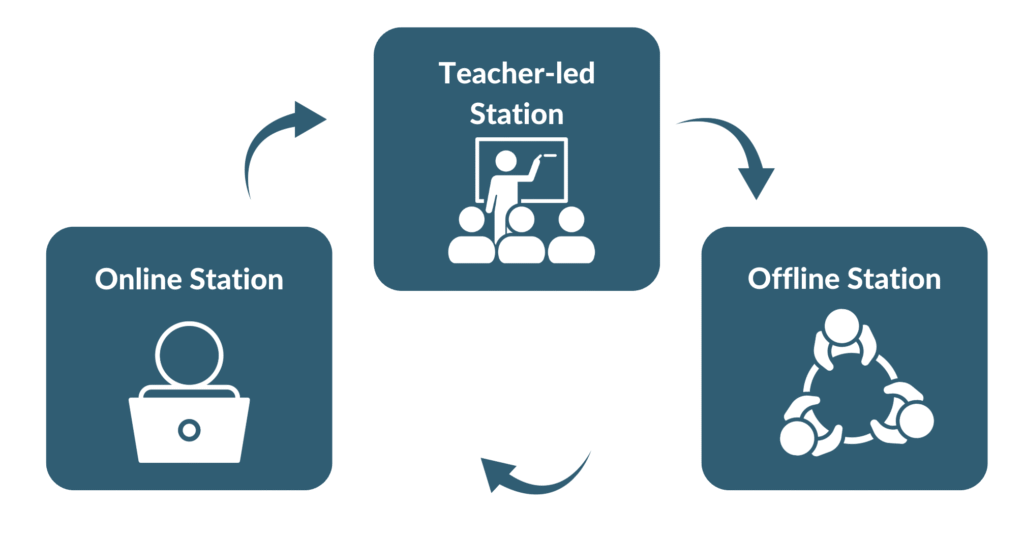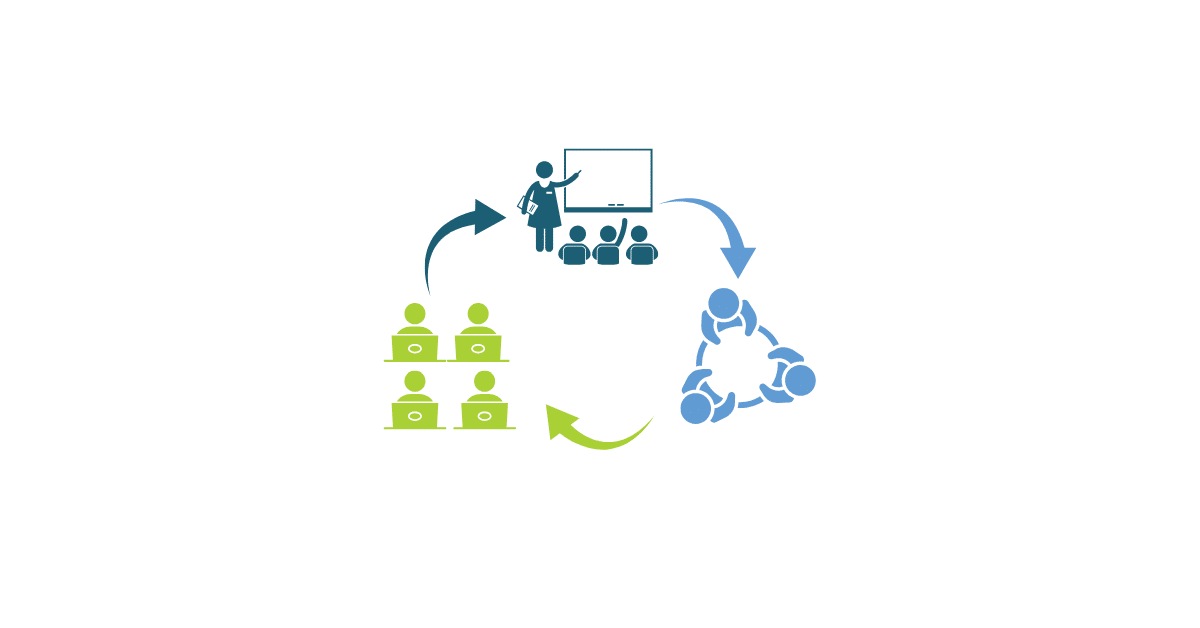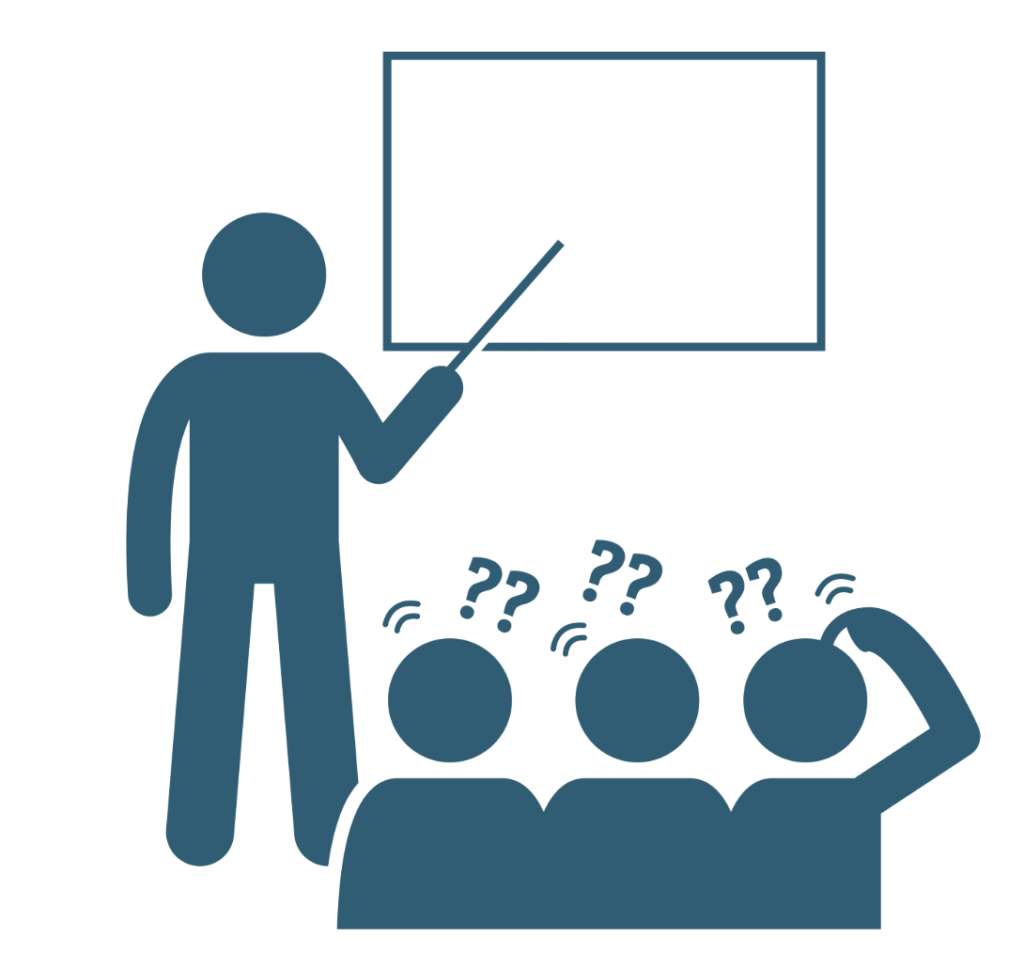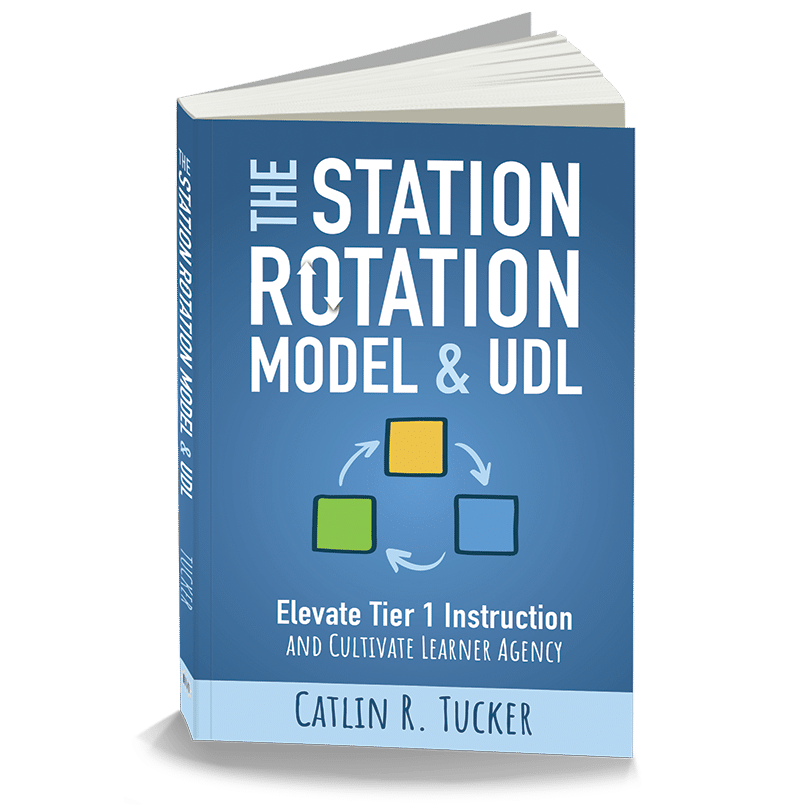Related Podcast Episode
How can I use the station rotation model effectively with multilingual learners who are new to English? How can I design independent and collaborative stations that students can navigate successfully while I work with small groups at the teacher-led station?
A teacher asked me these questions at the end of my station rotation training last week. They reflect a unique challenge facing teachers who work with multilingual learners. Students in the same class often have very different levels of English language proficiency and benefit greatly from differentiated, small-group instruction. At the same time, it can feel daunting to release students who are still developing their English language skills to independent and collaborative online or offline stations without the teacher present to guide the experience. As a result, those tasks must be accessible, engaging, and designed to help learners make meaningful progress.
This blog post is the first in a series exploring how we can design lessons using the station rotation model to support both English language development and the skills of self-direction and self-regulation.
The Challenge with Whole Group, Teacher-led Language Instruction
In a whole-group, teacher-led lesson, especially one that relies heavily on verbal instruction, multilingual learners who are newer to English can face several barriers.
- Pace of Instruction: The lesson may move too quickly for students who need more time to process spoken English or translate new vocabulary.
- Lack of Differentiation: In classes where students are at different stages of English language development, it can be challenging for a teacher using whole-group lessons to meet the varied needs of all learners. Without differentiation, those at earlier stages may not receive the targeted support they need, and those with more developed language skills may not encounter the necessary challenge to stay meaningfully engaged in the learning.
- Limited Opportunities for Authentic Speaking Practice: Whole-group settings may include choral responses as students practice saying specific words or teacher-facilitated class discussions, but they often do not allow for much student-to-student interaction. This reduces the opportunities that students have to practice their speaking and listening skills in authentic, meaningful, and conversational ways.
- Generalized Rather Than Targeted Scaffolds and Supports: Whole-group lessons may include scaffolds such as sentence frames, visuals, and gestures; however, these supports may not be tailored to meet the specific language development needs of students at different proficiency levels. As a result, some learners may still struggle to access and make meaning of the content, while others may not be getting the level of challenge they are ready for.
- Lack of Cognitive Challenge: Whole group lessons designed to accommodate a wide range of language levels may unintentionally lower the cognitive demand of tasks. Without access to rigorous, culturally responsive learning experiences, multilingual learners may miss out on the kind of productive struggle that supports both language growth and deeper learning.
- Overreliance on the Teacher: In whole-group settings, multilingual learners may become overly dependent on the teacher to lead every step of the learning process. This can make it harder for them to develop the independence and self-direction they’ll need to navigate other classes with confidence.
In a systematic literature review focused on solutions to the challenge of long-term English language learners, Furuma (2025) identifies many conditions that may make it difficult for students to develop academic English proficiencies. Many of the challenges mentioned above, such as over-reliance on teacher-led instruction and lack of differentiated support aligned to students’ specific language development needs, are identified as contributing factors to the persistent gaps in language and academic development for multilingual learners. The whole group, teacher-paced approach to instruction can leave our newest English language learners behind, feeling lost and frustrated, even when we are working hard to include them.
To create more equitable and effective learning experiences, we need instructional models that allow for differentiation, peer collaboration, more processing time, and targeted language support. The station rotation model provides a structure that enables teachers to intentionally group students based on data, personalize instruction and scaffolds, and create space for students to actively use and develop language in meaningful ways. When implemented with intention, this model can shift the dynamic from teacher-led to student-centered, better supporting multilingual learners at every stage of language development.
How the Station Rotation Model Can Help
The station rotation model is a flexible technology-enhanced instructional approach in which students rotate through a series of learning activities, including teacher-led, online, and offline stations. Each type of station provides a unique type of support, allowing students to engage with the content and each other in multiple ways, as shown below.
🍏 Teacher-led
Ideal for differentiated instruction, guided support, and language modeling
Small group guided reading with leveled texts, analysis support, and vocabulary instruction
Speaking and listening activities with visuals and sentence stems
Real-time feedback on writing or speaking tasks
Scaffolded, teacher-facilitated academic conversations
Explicit instruction in language learning strategies
Focused grammar and pronunciation practice
💻 Online
Ideal for multimodal input, adaptive practice, and student self-pacing
Listening comprehension activities with videos, podcasts, or audio recordings
Interactive vocabulary games with images and audio
Online reading tasks with built-in scaffolds (e.g., audio support)
Digital tools for speaking or fluency recording and playback
Building background activities with curated online resources
Formative assessments to measure student progress
🎨 Offline
Ideal for tactile, social, collaborative, and creative learning activities
Storyboarding or comic strip creation to retell a story or summarize content
Pen-and-paper vocabulary and grammar practice
Small-group, student-led discussions with visual prompts and sentence frames
Artistic or labeling tasks
Collaborative games, like word sorts and matching activities
Writing short texts or reflections using anchor charts or word banks
The station rotation model is especially valuable when the content or skills are challenging, or when pre-assessment and formative assessment data reveal a wide variation in what students know and can do. In these moments, whole group instruction may not offer enough flexibility or support for all learners. By contrast, station rotation allows teachers to break the class into smaller groups and target instruction more effectively.

It’s important to note that this model is not ideal for every lesson. There are times when keeping the class together can create shared experiences that spark curiosity, build background knowledge, or support meaningful dialogue. For example, teachers might launch a unit with a provocation, engage students in a whole-class role-play activity, facilitate a fishbowl or spiderweb discussion, or guide the class through a visual thinking routine. These moments are often more powerful when students learn together, drawing on shared language supports, and contribute to the collective understanding of a topic. However, when the data shows that students are in very different places in terms of their skills and needs or when the task is cognitively or linguistically demanding, the station rotation model provides a structure that makes differentiation manageable and learning more accessible.
For multilingual learners, the station rotation model creates three distinct learning spaces that offer:
- Personalized support at the teacher-led station, where the teacher can scaffold vocabulary, model strategies, and respond to individual needs.
- Peer interaction and meaning-making in collaborative stations where students can build understanding together, using language in context.
- Self-paced independent stations where students apply skills, revisit resources, and work at a pace and on tasks appropriate to their readiness.
Each station can be intentionally designed with visuals, repeated exposure, bilingual supports, and clear routines to make learning more accessible. Just as important, the station rotation model provides a built-in structure for gradually releasing responsibility from teacher to student. This helps multilingual learners become more independent, self-directed, and confident. By shifting from whole-group to small-group learning, we create new opportunities to meet students where they are, support their language development, and build the strategic learning skills they need far beyond our classrooms.
What’s Next In This Series?
This post focused on the why, or value, of using the station rotation model to meet the needs of multilingual learners. In upcoming posts, I’ll share specific strategies and classroom examples to help you design practical and accessible stations for your students. Here’s what is ahead in this series!
- Part 2: Differentiating at the Teacher-led Station—How to tailor instruction based on language proficiency, provide targeted scaffolds, and model strategies that multilingual learners can apply in other stations.
- Part 3: Designing for Self-Direction at the Online and Offline Stations—Ways to support early language learners in navigating independent and collaborative tasks with confidence, using routines, visuals, and other supportive strategies.
- Part 4: Cultivating Self-Regulated and Strategic Learners Over Time—Metacognitive and reflective routines designed to help multilingual learners develop agency, set goals, monitor their progress, advocate for their needs, and think about their learning.
This series is all about making the station rotation model work for multilingual learners, ensuring that the learning meets their specific needs.
If you want to delve deeper into designing inclusive, student-centered learning experiences, check out my new book, The Station Rotation Model and UDL: Elevate Tier 1 Instruction and Cultivate Learner Agency. This book guides teachers in using the station rotation model to put Universal Design for Learning (UDL) into action in their classrooms, making learning more accessible, engaging, and effective for all students.
The Station Rotation Model and UDL: Elevate Tier I Instruction and Cultivate Learner Agency is available now! I’d love for you to check it out, share it with a colleague, and let me know what resonates most with you. If you have any questions about the book, please post a comment!I
School leaders interested in using the book for a staff-wide study can place a discounted bulk order for 10 or more copies. If you and your teachers need additional support, I offer customized professional learning that is hands-on, practice-based, and tailored to your team’s needs. Together, we can support your teachers in developing their UDL practice, differentiating instruction more effectively, and elevating Tier 1 instruction. We can even utilize the Station Rotation Model to create space for Tier 2 support and Tier 3 intervention within general education classrooms. And, we can explore how this model can help us position students as active agents leading their own learning!




One response
Great article, Catlin! The station rotation model makes language learning more flexible and supports student independence. Excited for the rest!